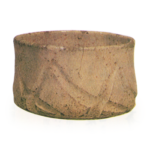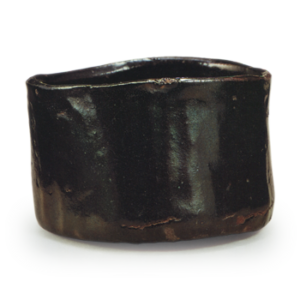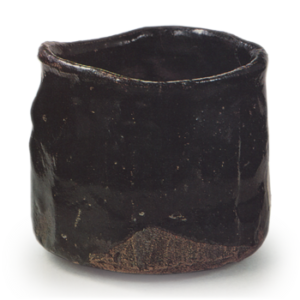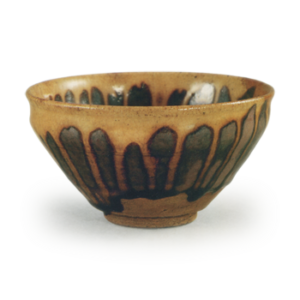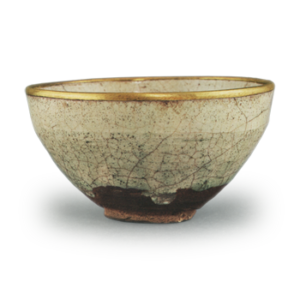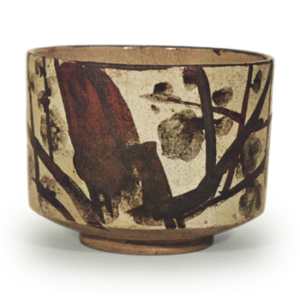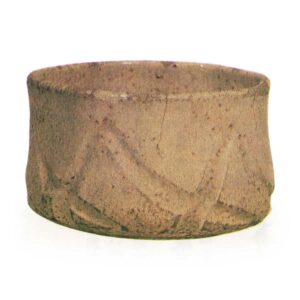
This is an old kiln of Karatsu ware. Kishidake, now renamed Kishitake, is located in Kitahata Village, Higashimatsuura County, Saga Prefecture. It is said that the Iidong Kiln with a transparent ash glaze of northern Korean origin was founded in the mountains to the west of Kishitake during the Wonheng era (1321~4) during the reign of Emperor Godaigo. Although the origin of Dangjin ware is said to be extremely old, this was the first time that glazed ceramics were used. In later years, the Hobashira kiln with opaque glaze was established in the Hobashira Mountains to the southwest of the Iidong kiln, the Saraya kiln in Sugitani of Hieda (Kitahata Village), the Donoyadani, Hiramatsu, and Otani kilns in Aichi Village (Aichi Town in the same county), and the Kojukanja kiln in Kirigi Village (Kirigi Town in Hizen County). These kilns developed greatly for 270 years until 1594 (Bunroku 3), partly due to the protection and encouragement of the Hata clan, the lord of Kishitake Yoshishimi Castle, and produced today’s so-called “old Karatsu”. The potters fled to the east and opened the upper and lower kilns in Yamase (Yamase, Hamatama-cho, Hamadama-cho, Hamadama-gun), fled to the west and established the Hazeya Kiln in Minamihata Village (Minamihata-cho, Imari City), or went far away and established the Nijuhaya Kiln in Mikawachi (Mikawachi, Sasebo City, Nagasaki Prefecture).
Kiganitake Iidong Jar Kiln] Oaza Hobashira Aza Ayuki, Kitahata Village. The kiln is of the split bamboo type, shaped like a bamboo split in two and laid face down. The partition between the kiln chamber and the ceiling is shaped like a kamaboko-shaped bamboo. The kiln floor still exists today.
The excavated objects include various types of jars, tokkotsu, suribachi, kataguchi, teacups, sake cups, and others. The glazes are transparent black-green and grayish-white, with small, strong penetrations on one side. From the mid-19th century, the first examples were produced with rough iron glaze and grayish-white glaze. In other words, this was the beginning of ekaratsu. In the latter half of the period, E-Daratsu was produced using patterned paper and iron glaze to create a floral pattern.
Kishitake Hobashira Kiln] Hobashira Kiln is located in Hobashira, Kitahata Village. The kiln is of the split bamboo type. The kiln is split bamboo type. The variety, clay, and techniques are the same as those of the Iidora Kiln, but the glaze is less black-green and grayish-white, and up to 90% is opaque sea squirt glaze. This is the origin of sea squirt glaze in Japan, and the oldest of the Joseon dangjin wares. The skin whale-te technique originated in this kiln. The outwardly curved rim of the tea bowl is a characteristic of this kiln, and guiimomi (a small bowl with a small cup) was most frequently made here. This kiln was probably not a branch of the Iidong kiln, but was opened separately by a potter who came from Korea. Kishitake Iidong Jangjo Kiln] Aza Ayuki, Oaza Hobashira, Kitahata Village. It is thought to be a branch kiln of the Iidong kiln, and the kiln style and other features are almost the same. The kiln style and other details are almost the same. The work is a little thicker and the firing is a little lukewarm.
Kishitake Saraya Kiln] Oaza Hieda Aza Sugitani, Kitahata Village. It is a branch kiln of the Hobashira Kiln and has the steepest slope of all the Kishitake Kogama kilns. Only the kiln floor remains now. Most of the techniques and glazes are the same as those used in the Hobashira kiln. The large jars and tokutsu contain a thin transparent glaze that does not melt well and has a yellowish tinge. The majority of Korean karatsu wakes were made at this kiln.
Kishitake Donoyadani Kiln】Kishitake Donoyadani Kiln is located in Aza Donoyadani, Oaza Kamisari, Souchi Town, Higashimatsuura County. It is the kiln with the longest ascent of all the Kishitake kilns, and is equal to the Iidora Kogama kiln in terms of the variety and other features, but one-third of the products have sea squirt glaze. Particularly important is the production of tenmoku tea bowls, and there are also some prototypes of tea containers. Ekaratsu was most advanced at this kiln.
Kishitake Hiramatsu Kiln] Located in Aza Hiramatsu, Kamisari, Oaza, Sochi Town. The kiln is similar to the Iidora Kiln in the variety and kiln techniques, but the iron content of the clay is high and the glaze color is blackish green with some kiln distortions. Umigumi glaze and ekaratsu are not produced.
The above kilns were opened between 650 and 400 years ago.
The kilns were closed in 1594. (Kyoichi Kimbara)

